The Florida Maglev Project
This page contains information from the Executive Summary prepared by the Florida Maglev Deployment Planning/Design Team for submission to the Maglev Deployment Program of the Federal Railroad Administration in June, 2000
Leading-edge American scientific and practical know-how are once again being joined together on the Space Coast of East Central Florida to open new horizons. It is time to embrace the transporta- tion "mode of the future" and decisively pull it into the present. This reach to the future has succeeded before right here, where our space program was born.
About the time of the Gemini and Apollo programs, Drs. James Powell and Gordon Danby invented the magnetic levitation transportation system that would use repelling superconducting magnets to move vehicles quietly and efficiently along a guideway at over 380 km/h (240 mph). Years later, the Japanese advanced these design breakthroughs further and are now building the maglev system that will supplement their bullet trains with an even faster 300 mph connection.
Central Japan Railway Company - Yamanashi Maglev Test Line
MAGLEV 2000 of Florida Corporation, in partnership with Florida Department of Transportation and other agencies, is currently validating the next generation of the Danby-Powell Maglev Technology at Titusville's Space Coast Regional Airport.
The Federal Railroad Administration (FRA) has also selected the MAGLEV 2000 technology to connect the Space Coast Regional Airport to Port Canaveral via the Kennedy Space Center Visitors Center as one of seven candidate projects for its current Maglev Deployment Program.
Up to now, maglev technology has been limited to test tracks in opposite parts of the world. Germany built a test track to showcase a different maglev technology and is participating in FRA deployment studies in other states. The Central Japan Railway Company is conducting full-scale tests along pats of its new mountain tunnel route, as mentioned above, using the Danby-Powell maglev principles. But the Maglev 2000 system represents a second generation of maglev development, an all-American application designed to meet specific American challenges. The sheer distances of this country and the spread-out living patterns of America call for a transportation system that is fast, reliable, economical to build, easy to operate and maintain and capable of hauling heavy freight.
MAGLEV 2000's breakthroughs in superconducting magnets, low-cost guideway construction and high-speed electronic switching take maglev into an exciting phase of new transportation solutions for America. The 20-mile MAGLEV 2000 project on the Space Coast will offer a showcase for the new technology and at the same time provide a useful transportation service to residents and visitors alike. Port Canaveral has grown spectacularly as a cruise port for many types of ships and the Kennedy Space Center continues to be a premier attraction in the area. These popular destinations supply the impetus for constructing a maglev route to serve them. MAGLEV 2000 is also exploring the steps necessary to take the new system to the greater Orlando area in a second stage, reaching the International Airport and beyond to the Attractions area. This connection would provide many further economic and transportation benefits to Brevard County and all of central Florida, as well as greatly strengthen the financial performance of the project. In fact, the project's financial advisor, Salomon Smith Barney, considers an Orlando to Port Canaveral system to be the most commercially viable of all the FRA maglev projects being considered.
The Technology
The Danby-Powell Maglev Technology relies on the property of magnets that similar electrical charges repel each other and maintain a gap. Since a smaller gap produces a stronger magnetic force, any deviations in the channeling of forces between a maglev vehicle and the guideway (or "track") of the system automatically returns the vehicle to its correct center position. The system is inherently stable.
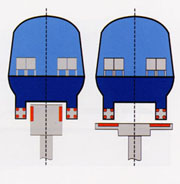 The technology uses
superconducting magnets mounted on the maglev vehicle to induce currents into a continuous
row of coils on the guideway. These currents create the magnetic forces that lift and
stabilize the vehicle. Other currents propel the vehicle along the guideway. Drs. Danby
and Powell invented this system in the 1960s and watched its development in Japan into the
successful first stages of a second Tokyo-Osaka high-speed transportation system. Their
new Maglev 2000 system has new patented refinements that make it extremely attractive for
North American uses. Four major design refinements distinguish the Florida Maglev
project.
The technology uses
superconducting magnets mounted on the maglev vehicle to induce currents into a continuous
row of coils on the guideway. These currents create the magnetic forces that lift and
stabilize the vehicle. Other currents propel the vehicle along the guideway. Drs. Danby
and Powell invented this system in the 1960s and watched its development in Japan into the
successful first stages of a second Tokyo-Osaka high-speed transportation system. Their
new Maglev 2000 system has new patented refinements that make it extremely attractive for
North American uses. Four major design refinements distinguish the Florida Maglev
project.
Quadrupole magnets: Using a four-sided
superconducting magnet provides two faces, one horizontal and one vertical, which have
identical charges at any one time. This allows the magnets to induce magnetic forces into
either vertical or horizontal coil panels, corresponding to two guideway types. The
four-sided magnets also cancel the magnetic forces to zero in other directions, which has
the benefit of suppressing electromagnetic fields. The MAGLEV 2000 system has magnetic
field measurements that are less than those encountered in one's own home.
Narrow beam guideway: The strong magnetic forces of the super-conducting
magnets allow for levitation along a narrow beam (less than four feet wide). This
eliminates the costly guideway structures of earlier maglev systems and substitutes a
simple, less obtrusive elevated structure. Coil panels are mounted on the sides of the
narrow beam and interact with the vertical magnetic fields of the quadrupole magnets to
lift, stabilize and propel the vehicle.
Planar guideway: This is a flat version of the guideway, where coil
panels are mounted horizontally and interact with the horizontal field of the quadrupole
magnets on the vehicle. This eliminates the need for a central beam along the guideway by
substituting the same force for lift, stability and propulsion.


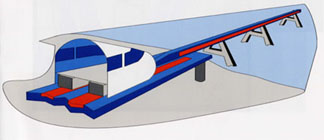
High-speed electronic switch: The planar guideway allows the next step of
mounting a diverging line of coil panels to form a switch very similar to a steel railroad
switch in its design and function. By powering the coils on one branch or the other, the
maglev vehicle is guided by its superconducting quadrupole magnets onto the proper route.
There are no moving parts, which eliminates what has been, up to now, the most serious
drawback of maglev guideway designs.
Routes and Operations
The MAGLEV 2000 project description identified four routes or variations to connect the
Space Coast Regional Airport with the Kennedy Space Center (KSC) Visitors Center and Port
Canaveral (Minimum Operating Segment I or MOS-I). Three of the alternatives start at the
Airport, cross the Indian River alongside the NASA Parkway to the KSC Visitors Center. Two
of the alternatives then generally follow traffic corridors on Merritt Island before
crossing the Banana River on one side or the other of the Route 528 causeway. A third
Merritt Island route stays entirely on federal lands and crosses the Banana River somewhat
north of the current causeway to reach Port Canaveral. A fourth alternative has two
services that start at the Space Coast Regional Airport (SCRA), one that travels south on
the mainland before turning east to follow Route 528 all the way to the Port and another
that operates as a shuttle to the KSC Visitors Center over the NASA Causeway route.
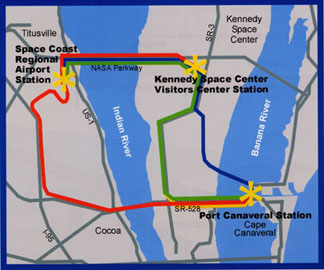
MAGLEV 2000 expects that a maglev project along one of these routes can provide
transportation service to Port Canaveral cruise ships for passengers arriving by charter
plane or car at the SCRA. An operations plan has been developed to allow both passengers
and baggage to be carried from the Space Coast Regional Airport and its parking areas to
departing or incoming cruise ships quickly (in 10 minutes or less) and efficiently. At the
same time, maglev connections to the KSC Visitors Center can help NASA consolidate its
visitor stream and provide 5-minute connections to the mainland both at normal times and
when facing peak event loads
Environmental Assessment
These roughly defined routes are still wide corridors that were used to sketch out an
overview of possible environmental and community impacts along the route. Much further
refinement must occur in the next phase of environmental analysis to determine an exact
alignment along one or the other of these. The purpose of the Environmental Assessment
carried out to date is to note any major environmental issues that might jeopardize the
practical feasibility of any or all routes. The results of environmental analysis so far
indicate that no major problems exist that cannot be lessened or eliminated by reasonable
mitigation or avoidance measures, although some sensitive habitats still need to be more
clearly defined. Certainly lower emissions will improve air quality in the region. These
findings are an encouraging sign that the next stages of draft and final environmental
impact documents for federal and state requirements will lead to an acceptable project on
environmental issues. With continued federal funding for the MAGLEV 2000 project, the DEIS
process would be completed in 2001.
Ridership and Revenue
The MAGLEV 2000 project is planned for revenue service in 2009 and is expected to grow to
carry over 2 million passengers between the SCRA and Port Canaveral each year (2020
estimate). Maglev riders visiting the Kennedy Space Center may number as many as 650,000
per year (again in 2020). It is expected that a majority of Port passengers will travel on
fares built into cruise packages ("including all transfers"), while more KSC
passengers may buy either single tickets or day passes with maglev passage included. In an
effort to ensure realism in these calculations, growth rates and passenger loadings
obtained from the State of Florida and the port and airport authorities have been kept to
lower bounds. The maglev market shares for 2020 are thus 22% of port passengers and 6% of
space center visitors, or an overall average of 15% of all traffic. These conservative
estimates show a positive operating climate for the initial stage of the project. The
tables also show a convincingly profitable system with the 35-mile extension to Orlando.
| Ridership Forecast Summary | ||||
With Extension to Orlando |
||||
| Year | MOS-1 | MOS-1 | Extension | Corridor |
| 2009 | 14,372,000 | - | - | - |
| 2011 | 2,053,838 | 6,440,082 | 11,082,327 | 12,659,314 |
| 2013 | 2,292,528 | 7,213,957 | 12,348,285 | 14,110,858 |
| 2015 | 2,559,453 | 8,082,762 | 13,763,062 | 15,733,452 |
| 2020 | 3,227,087 | 10,126,148 | 17,027,174 | 19,520,432 |
| 2025 | 3,830,808 | 11,988,491 | 20,016,700 | 22,982,284 |
| 2030 | 4,548,217 | 14,197,774 | 23,544,984 | 27,072,378 |
| 2040 | 5,786,831 | 18,040,822 | 29,795,594 | 34,288,508 |
| 2050 | 6,911,336 | 21,555,816 | 35,604,424 | 40,970,288 |
| Yearly Revenue Forecast Summary (millions of $) | ||||
| With Extension to Orlando | ||||
| Year | MOS-1 | MOS-1 | Extension | Corridor |
| 2009 | 14,372 | - | - | - |
| 2011 | 16,637 | 40,377 | 179,605 | 219,982 |
| 2013 | 18,557 | 45,123 | 199,875 | 244,998 |
| 2015 | 20,703 | 50,440 | 222,501 | 272,941 |
| 2020 | 26,079 | 62,930 | 273,976 | 336,906 |
| 2025 | 30,941 | 74,351 | 321,449 | 395,800 |
| 2030 | 36,716 | 87,876 | 377,382 | 465,257 |
| 2040 | 46,697 | 111,528 | 477,208 | 588,736 |
| 2050 | 55,768 | 133,262 | 570,582 | 703,844 |
Costs and Benefits
The full constructed cost of the 20-mile Titusvilie to Port Canaveral system is
estimated to cost just under $600 million. This includes all planning and design
activities, construction of a double guideway for the entire length of the segment, three
stations with passing sidings and baggage spurs, as well as 14 vehicles for passengers and
baggage. Annual operating costs are expected to be in the range of $14 million per
year after startup. As noted previously, revenues are expected to cover the costs
of operation from the start, with capital investment depreciated over the 41- year
lifespan of the project.
The largest single cost of any maglev project is the guideway. The estimate for this item,
considered without other project costs or inclusion of special items, such as water
crossings, comes to under $14 million per double guideway mile for a high-capacity
system for carrying passengers and freight. This order-of-magnitude estimate
helps to show how the Danby-Powell Maglev Technology can significantly reduce costs in the
distance-driven North American transportation environment.
The ridership of the MAGLEV 2000 project will generate revenues of over $26 million
annually and up to $337 million annually (2020 estimate), if the Orlando corridor
extension is built.
But economic benefits go well beyond the revenues collected from ticket sales and used for
operations. The project's ability to cope with the region's traffic growth should reduce
the pressure to expand highways and causeways, even as cruise line boardings grow
strongly. The Environmental Assessment shows minimal impacts in most categories. However,
the upcoming Environmental Impact Statement will calculate the formal benefits and
impacts. Economic development in the region will be enhanced through the introduction of
new industry with well-paying jobs. Consumer surplus, an economist's measure of total
benefits to users beyond fares, shows a positive level of $837 million per year (in 1998
dollars) for the project and an impressive $6.5 billion when an Orlando extension is
calculated. Freight revenues can add another $2 million per year in revenues (based on
2020 traffic estimates).
American Content
A further advantage of the MAGLEV 2000 Florida project is that it consists of 100%
American technology. This technology has been proven in Japan's first generation line and
the MAGLEV 2000 refinements make it even more useful for American transportation needs.
Thus it has the potential to generate new high-tech jobs and skills for the domestic
economy. Florida's quiet but clear public commitment to MAGLEV 2000 technology development
over the last several years is based on the considerable local manufacturing and
employment benefits that a successful Maglev project can bring.
Public/Private Partnership and Management
A hallmark of the FRA Maglev Deployment Program is the close cooperation of the public and
private sectors in the high-tech startup of maglev development and operation. The FRA
expects that its federal investment will contribute not just to the construction of a
single project. Rather they also wish to support the development of a unique body of
knowledge and expertise that will launch a new American industry for domestic
infrastructure renewal and global export opportunities.
MAGLEV 2000's partnership with the Florida Department of Transportation (FDOT) in
Tallahassee and its continued sup- port by the Technology Research and Development
Authority (TRDA) in Brevard County points to a similar goal for economic development in
East Central Florida.
In the current preconstruction planning phase, MAGLEV 2000 has enlisted the support of
numerous local agencies and private companies. Public partners include:
Private companies have also expressed willingness to invest their expertise and resources in the project:
Still other partners will join in specialized roles as the project design becomes more firmly fixed. It is expected that the project management team will be reformulated in each of three distinct phases:
Project Schedule
MAGLEV 2000 expects to have its 20-mile Minimum Operating Segment up and running by the
beginning of 2009. This makes allowances for about two years of environmental work and
engineering development, four years of construction, plus another two years for
certification and testing of the initial segment. Extensions to Orlando or other parts of
Central Florida could follow soon after.
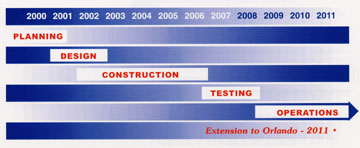
Space Coast in the Lead Again
The Florida Maglev Deployment Project has the potential to shine the technological
spotlight on the Space Coast again. It is THE American maglev project and it has the
greatest potential to reshape our nation's transportation services and will again let a
locally developed product achieve national significance.
The 20-mile MAGLEV 2000 system will perform a useful and safe transportation service at an
attractive cost for a new technology start up of great industrial promise. And the
environmental benefits of the project ensure that the quality of the environment will
remain unpolluted and the beauty of the region unspoiled.
MAGLEV 2000 is a strong partner for the future of Brevard County, Central Florida and the
United States. This is only the beginning. MAGLEV 2000's ability to haul container
freight, its application to lower-speed circulator uses, such as a university campus or
urban activity centers, and its efficiency in specialized industrial tasks, such as mining
and even space launches, promise a bright future and a significant place in the nation's
transportation system.
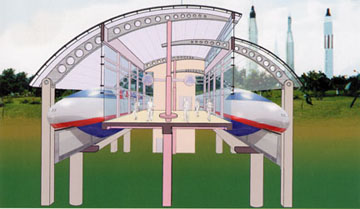
For additional information, contact John J. Morena, at MAGLEV 2000, Florida Project Office, 6995 Tico Road, Titusville, FL 32780; Phone: (321) 267-0910; fax: (321) 267-1006 and/or Nazih K. Haddad, Manager, Intercity Rail, Florida Department of Transportation, 605 Suwannee Street, Mail Station 57, Tallahassee, FL 32399-0450, 850-414-4534; fax 922-4942
Last modified: August 13, 2002